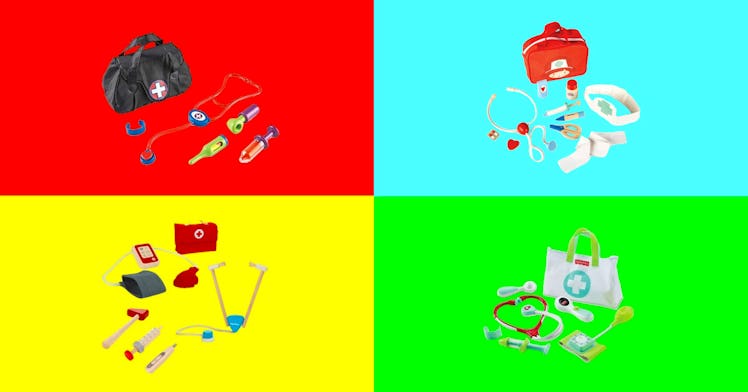The Best Toy Doctor Kits for Kids Trying to Make Sense of a Pandemic
Doctor toys used to just help kids be less afraid of the doctor's office. Now they help them cope with the world.

If your toddler is like most kids, they’re less than thrilled to go to the doctor. The reason can be summed up in one word: shots. Most kids over the age of 2 have certain not-so-great associations with seeing the pediatrician, compounded by the fact that they don’t yet understand the longterm importance of regular check-ups or vaccines. It’s hard to explain that just because they got a shot last time, doesn’t mean things will hurt this time. That’s where doctor toys come in.
“Most parents are going to be able to see the utility in that type of medical kit. It relieves anxiety in kids about going to the doctor,” says Dr. Tomomi Hayashi, a pediatrician at Silicon Valley Pediatricians. “They help kids learn about how procedures are done before they are done.”
A kid’s doctor kit is what’s called a real-world toy, which mimics what kids see adults around them using and helps them make sense of those grown-up activities. Doctor kits specifically have the added benefit of making kids feel more comfortable around medical instruments, like stethoscopes or reflex hammers, that they’ll see at their pediatrician’s office and gives them a feeling of control over something (a flu shot, for instance) that might otherwise be scary.
When choosing a kid’s doctor kit, make sure there are no small parts that toddlers or preschoolers can put in their mouths. That includes toy tongue depressors, which Hayashi doesn’t like for safety reasons: “I don’t want a child to think it’s OK to shove things into people’s mouths.”
As for the toys included in doctor kits, reflex hammers and thermometers are nice additions, as is an otoscope, which doctors use to check kids’ ears. Hayashi is a fan of doctor kits that include stethoscopes and badges: “Kids see doctors wearing those and they make a kid feel comfortable around doctors. I have a stethoscope on my neck, so kids can get frightened by it when I’m coming at them. So it’s nice when they recognize it,” she says. “Big plastic fat syringes are OK. A blood pressure cuff is cute, because we start taking that when kids are 3 years old.”
If you can, get your kid a white lab coat, since that’s generally what doctors wear to work. Even an oversize white T-shirt cut down the front will work. The young physicians, however, shouldn’t play doctor on actual humans their own age.
“Young kids should learn to do exams on their toys until they learn to do it safely,” says Hayashi. “They should examine their favorite toy and not another child, because they can be too aggressive.” Based on Hayashi’s recommendations, these toy doctor kits fit the bill; all are suitable for kids 2 and up.
Every product on Fatherly is independently selected by our editors, writers, and experts. If you click a link on our site and buy something, we may earn an affiliate commission.